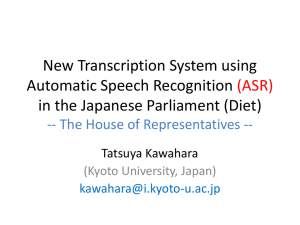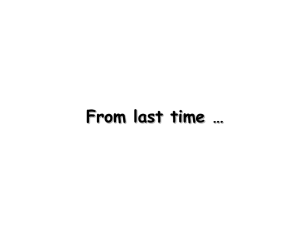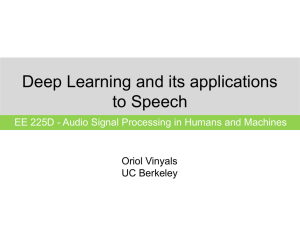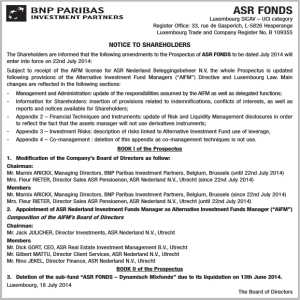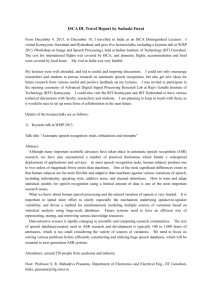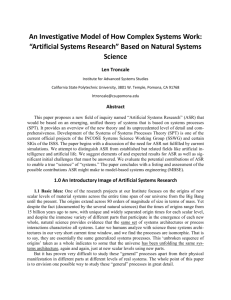2-page proposal file
advertisement
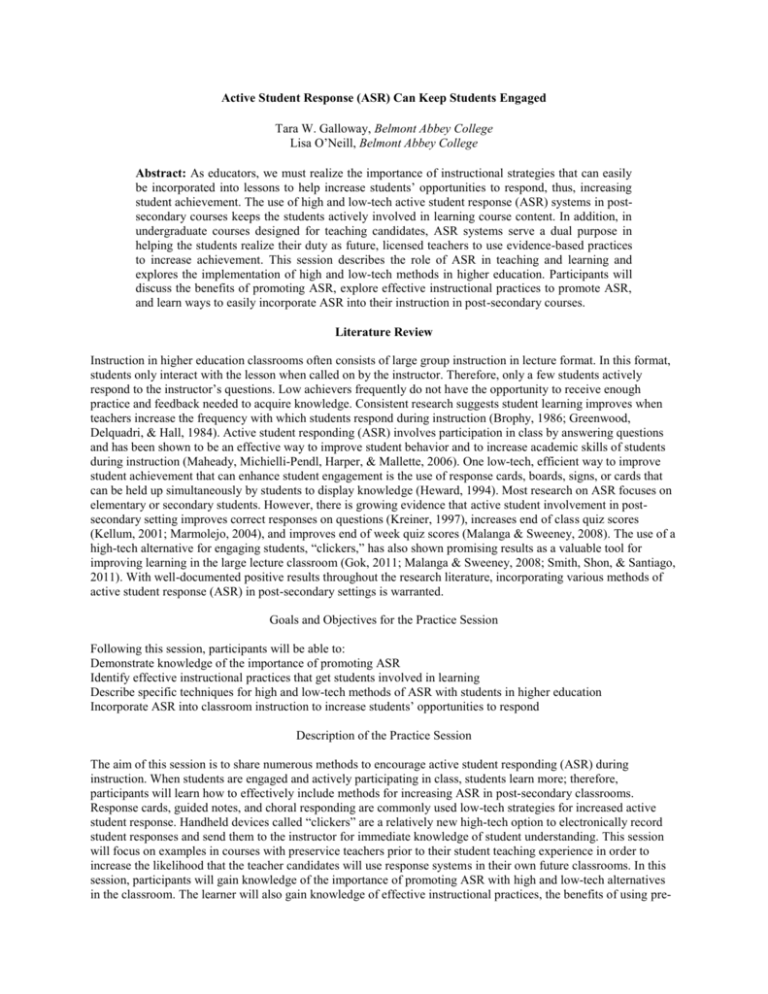
Active Student Response (ASR) Can Keep Students Engaged Tara W. Galloway, Belmont Abbey College Lisa O’Neill, Belmont Abbey College Abstract: As educators, we must realize the importance of instructional strategies that can easily be incorporated into lessons to help increase students’ opportunities to respond, thus, increasing student achievement. The use of high and low-tech active student response (ASR) systems in postsecondary courses keeps the students actively involved in learning course content. In addition, in undergraduate courses designed for teaching candidates, ASR systems serve a dual purpose in helping the students realize their duty as future, licensed teachers to use evidence-based practices to increase achievement. This session describes the role of ASR in teaching and learning and explores the implementation of high and low-tech methods in higher education. Participants will discuss the benefits of promoting ASR, explore effective instructional practices to promote ASR, and learn ways to easily incorporate ASR into their instruction in post-secondary courses. Literature Review Instruction in higher education classrooms often consists of large group instruction in lecture format. In this format, students only interact with the lesson when called on by the instructor. Therefore, only a few students actively respond to the instructor’s questions. Low achievers frequently do not have the opportunity to receive enough practice and feedback needed to acquire knowledge. Consistent research suggests student learning improves when teachers increase the frequency with which students respond during instruction (Brophy, 1986; Greenwood, Delquadri, & Hall, 1984). Active student responding (ASR) involves participation in class by answering questions and has been shown to be an effective way to improve student behavior and to increase academic skills of students during instruction (Maheady, Michielli-Pendl, Harper, & Mallette, 2006). One low-tech, efficient way to improve student achievement that can enhance student engagement is the use of response cards, boards, signs, or cards that can be held up simultaneously by students to display knowledge (Heward, 1994). Most research on ASR focuses on elementary or secondary students. However, there is growing evidence that active student involvement in postsecondary setting improves correct responses on questions (Kreiner, 1997), increases end of class quiz scores (Kellum, 2001; Marmolejo, 2004), and improves end of week quiz scores (Malanga & Sweeney, 2008). The use of a high-tech alternative for engaging students, “clickers,” has also shown promising results as a valuable tool for improving learning in the large lecture classroom (Gok, 2011; Malanga & Sweeney, 2008; Smith, Shon, & Santiago, 2011). With well-documented positive results throughout the research literature, incorporating various methods of active student response (ASR) in post-secondary settings is warranted. Goals and Objectives for the Practice Session Following this session, participants will be able to: Demonstrate knowledge of the importance of promoting ASR Identify effective instructional practices that get students involved in learning Describe specific techniques for high and low-tech methods of ASR with students in higher education Incorporate ASR into classroom instruction to increase students’ opportunities to respond Description of the Practice Session The aim of this session is to share numerous methods to encourage active student responding (ASR) during instruction. When students are engaged and actively participating in class, students learn more; therefore, participants will learn how to effectively include methods for increasing ASR in post-secondary classrooms. Response cards, guided notes, and choral responding are commonly used low-tech strategies for increased active student response. Handheld devices called “clickers” are a relatively new high-tech option to electronically record student responses and send them to the instructor for immediate knowledge of student understanding. This session will focus on examples in courses with preservice teachers prior to their student teaching experience in order to increase the likelihood that the teacher candidates will use response systems in their own future classrooms. In this session, participants will gain knowledge of the importance of promoting ASR with high and low-tech alternatives in the classroom. The learner will also gain knowledge of effective instructional practices, the benefits of using pre- printed and write-on response cards, the benefits for using clickers for ASR, and specific techniques for using high and low-tech methods of ASR with students in post-secondary settings. The audience will participate in this session by actively participating with the material, discussing topics with peer groups, participating throughout session with response cards, and participating in a review game using response cards. Session participants will demonstrate knowledge gained by earning tickets for answering questions during final review game. Time will also be allotted for questions and answers. Discussion Given the fact that increasing opportunities to respond using ASR in the classroom produces higher achievement levels, this innovative approach serves a dual purpose when used in education courses. The teacher candidates benefit from the use of the response cards because of improved understanding of course content. Additionally, it is important for all beginning teachers to have knowledge of evidence-based instructional strategies; therefore, modeling this approach will enable the students in the classrooms of these future teachers to benefit from increased opportunities to respond, which improves student achievement. Furthermore, the instructor of the teacher education course gains formative data that can inform instruction to ensure students are meeting learning outcomes. Using various methods of ASR in higher education, especially preservice teacher training, creates a situation where all participants have positive outcomes. Regardless of the type of course, this instant feedback provides the instructor with valuable information to create an interactive learning environment by reteaching concepts, providing clarification, or stimulating further discussion based on students’ understanding. References Brophy, J. (1986). Teacher influences on student achievement. American Psychologist, 41, 10691077. Greenwood, C. R., Delquadri, J., & Hall, R. V. (1984). Opportunity to respond and student academic achievement. In W. L. Heward, T. E. Heron, D. S. Hill, & J. Trap-Porter (Eds.), Focus on behavior analysis in education (pp. 58-88). Upper Saddle River, NJ: Merrill/Prentice Hall. Heward, W. L. (1994). Three “low-tech” strategies for increasing the frequency of active student responding during group instruction. In R. Gardner, D. Sainato, J. Cooper, T. Heron, W. Heward, J. Eshleman, & T. Grossi (Eds.), Behavior analysis in education: Focus on measurably superior instruction (pp. 173-197). Belmont: Brooks-Cole. Kellum, K. K., Carr, J. E., & Dozier, C. L. (2001). Response-card instruction and student learning in a college classroom. Teaching of Psychology, 28, 101-104. Kreiner, D. S. (1997). Guided notes and interactive methods for teaching with videotapes. Teaching of Psychology, 24, 183 – 185. Maheady, L., Michielli-Pendl, J., Mallette, B., & Harper, G. F. (2002). A collaborative research project to improve the performance of a diverse sixth grade science class. Teacher Education and Special Education, 25, 5570. Malanga, P. R., & Sweeney, W. J. (2008). Increasing active student responding in a university applied behavior analysis course: The effect of daily assessment and response cards on end of week quiz scores. Journal of Behavioral Education, 17, 187-199. Marmolego, E. K., Wilder, D. A., & Bradley, L. (2004). A preliminary analysis of the effects of response cards on student performance and participation in an upper division university course. Journal of Applied Behavioral Education, 5, 319-345. Smith, L. A., Shon, H., & Santiago, R. (2011). Audience response systems: Using “Clickers” to Enhance BSW Education. Journal of Technology in Human Sciences, 29, 120-132.
